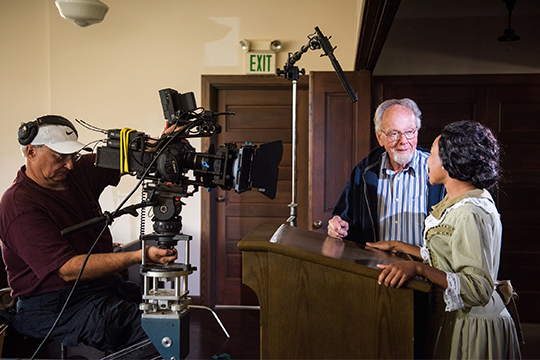 Director Dr. Ardon Albrecht coaches Jasmine Gatewood
Director Dr. Ardon Albrecht coaches Jasmine Gatewood By Erik M. Lunsford, LCMS Communications staff photojournalist and writer
It may be film director Rev. Dr. Ardon Albrecht’s swan song, but the swan needed caffeine to push through the long day of filming.
The former caffeine-free 78-year-old clutched a Starbucks Frappuccino under a portable tent in the front yard of Hope Lutheran Church in rural Alabama, tipped his straw hat embellished with white gaffers tape and the written words “The First Rosa 2014,” and peered at the monitor. He stroked his blondish goatee and surveyed a recorded scene.
“Yeah, that’s good,” said Albrecht, who was producer of the Synod’s popular weekly half-hour dramatic TV series “This Is the Life” for many of the years when it aired from 1952 to 1988.
It was an exhausting Day Three of a Sept. 22-26 project filming the documentary “The First Rosa” in and around Selma, Ala. The film tells the story of the life of Dr. Rosa Jinsey Young, known as “the mother of black Lutheranism in Alabama,” in the early years of the 20thcentury.
Director Dr. Ardon Albrecht coaches Jasmine Gatewood, an actress performing the role as young Rosa Young, during the filming of ‘The First Rosa’ documentary, Sept. 25, 2014, at Concordia College Alabama in Selma, Ala. On the left, Al Dowbnia, director of Digital Media Production at The Lutheran Church–Missouri Synod, prepares the camera.
LCMS/Erik M. Lunsford
The film project that pays tribute to the church confessor, planter and school starter is partially funded by The Lutheran Church—Missouri Synod, but needs continued donations to bring the film to completion.
Albrecht was hooked as a director after he read a few chapters from Young’s autobiography, Light in the Dark Belt.
“I had spent my early ministry as a missionary in Taiwan, so I knew missionary achievement when I saw it,” he said. “But never had I heard of a missionary establishing 30 Lutheran schools and 35 chapels. That’s what Rosa Young did, not to mention the role she played in the founding of Concordia College Alabama, where she successfully challenged an amazing number of black students to enter the preaching and teaching ministries.”
Perched on a camera dolly and donning a floppy hat to ward off the southern sun, the quiet Director of Photography Ben DeSousa was quickly leaping from thought to thought on camera angle, direction and the movement of movie extras in the scene. He was filming a scene with the young Rosa Young — performed by the perky Jasmine Gatewood — entranced under a tree, surrounded by a hive-like group of boys and girls role-playing students at recess. The Rev. Dr. Jon Vieker, executive producer on set and senior assistant to LCMS President Rev. Dr. Matthew C. Harrison, choreographed the children’s movements.
The set wrapped when the sun set. Crew members — Audio Engineer Mike Budzik, Assistant Amanda Booth, Cameraman Al Dowbnia, Technical Director and Video Engineer David Ramos, and DeSousa — meandered through the dinner line at Concordia College Alabama and settled into their chairs quietly. They were too exhausted to carry on anything more than casual conversation.
Albrecht temporarily left retirement to pursue the film. He said it’s the last — the actual last one — despite mild protest from an on-set photographer. It’s especially bittersweet for Kim Vieker, script supervisor on the film, executive assistant to President Harrison and Albrecht’s daughter. The two worked in near-orchestrated unison on the film set.
Albrecht said the film is the fruit of persuasive logic by Kaye Wolff and Susan Hill, two pastors’ wives from Michigan. He knew black Lutherans long wanted a film portraying Young’s life, but Wolff and Hill persuaded Harrison and Jon Vieker to begin a project in 2012. Two years later, and despite his age, Albrecht knew the Lord hadn’t failed him in stamina.
“In the months ahead I will count on Him to give me the strength to direct the post-production and editing of the show,” he said.
On set, Albrecht radiates respect. A simple “quiet” yields a thunderously silent response from the scene. It would only partially be a joke to think the birds were listening as well — although to Audio Engineer Mike Budzik, he’d most likely prefer to have the natural sounds on one of eight channels of audio juggles for each take.
On the final location, bordering a cotton field on a dirt road along a rural stretch near Selma, a municipal worker uses a machete-like tool to remove a contemporary road sign in favor of a vintage railroad one. Adjacent to a stop sign injured by bullet holes and various methods of disfigurement, a horse and buggy arrives as the sun drops below towering clouds. The light faded fast, and DeSousa worked quickly, orchestrating a scene involving extras portrayed as Ku Klux Klan members and the narrow escape of the Lutheran missionary Nils Bakke.
The film is slated for a 2015 release, but the project does not have enough funds to continue into production.
“I would appeal to anyone sitting on the fence,” said Albrecht, “to consider the serious shortage of black pastors and teachers in our church as well as the shortage of those of other ethnicities. We are so close to having a film to inspire young people to take on the mantle of full-time service to the Lord. Please help us bring it to completion.”
This story is used with permission from LCMS Communications.
To learn more about the life of Rosa Young or to donate to the film, go to lcms.org/thefirstrosa. To learn more about CUW’s screening of “The First Rosa” click here!
— This story is written by Kali Thiel. Kali was Director of University Communications until April, 2025.
If this story has inspired you, why not explore how you can help further Concordia's mission through giving.